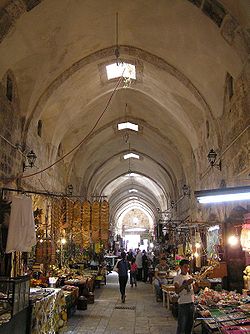Top Qs
Timeline
Chat
Perspective
Muslim Quarter (Jerusalem)
One of the four traditional quarters of Jerusalem's Old City From Wikipedia, the free encyclopedia
Remove ads
The Muslim Quarter (Hebrew: הרובע המוסלמי, romanized: Ha-Rovah ha-Muslemi; Arabic: حارة المسلمين, romanized: Ḥāraṫ al-Muslimīn) is one of the four sectors of the ancient, walled Old City of Jerusalem. It covers 31 hectares (77 acres) of the northeastern sector of the Old City.[1] The quarter is the largest and most populous of the four quarters and extends from the Lions' Gate in the east, along the northern wall of the Temple Mount in the south, to the Damascus Gate—Western Wall route in the west. The Via Dolorosa starts in this quarter, a path Jesus had to take when he was forced by Roman soldiers, on his way to his crucifixion.[2] The population of the Muslim Quarter was reported in 2012 as 22,000.[2]
Remove ads
Boundaries
Summarize
Perspective
The Muslim Quarter of Jerusalem is bordered by the Christian Quarter to the west, the Jewish Quarter to the south, and the Armenian Quarter to the southwest. The old city walls border the Quarter from the north.
The convention of a "Muslim Quarter", in what was then a Muslim-majority city, may have originated in its current form in the 1841 British Royal Engineers map of Jerusalem,[3] or at least Reverend George Williams' subsequent labelling of it.[4] The city had previously been divided into many more harat (Arabic: حارَة, romanized: Hārat: "quarters", "neighborhoods", "districts" or "areas", see wikt:حارة).[5] The city had previously been considered in sections relating to a much wider range of medieval groups. From the mid-19th century onwards, with the influx of Jewish immigrants, the areas of the city inhabited by Muslims began to decrease.[6]
The table below shows the evolution of the area today known as the "Muslim Quarter", from 1495 up until the modern system:[7]
Remove ads
History
The Muslim Quarter had a mixed population of Jews, Muslims and Christians until the 1929 Palestine riots.[8]
Some 60 Jewish families now live in the Muslim Quarter.[9] Yeshivat Ateret Yerushalayim is the largest yeshiva.[10]
In 2007, the Israeli government started funding the construction of The Flowers Gate development plan, the first Jewish settlement inside the Muslim Quarter since 1967. It would include 20 apartments and a synagogue.[11]
Remove ads
Landmarks
Jewish landmarks include the Kotel Katan or Little Western Wall, and the Western Wall Tunnels, which run below the neighborhood along the Western Wall. There are many Roman and Crusader remains in the quarter. The first seven Stations of the Cross on Via Dolorosa (Way of the Cross) are located there.[12]
See also
References
External links
Wikiwand - on
Seamless Wikipedia browsing. On steroids.
Remove ads



